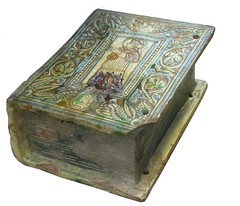By Stuart Frost
Two weeks have elapsed since my previous blog entry and as promised I can now reveal the function of the mystery object. Although some of you thought the object in question had a touch of the dungeon about it, I’m pleased to confirm that there is no connection with torture! The iron structure was once a horse-muzzle and it was collected by the V&A as a fine example of ironwork.
This week’s mystery object is a ceramic vessel that imitates the form of a book. Click on the thumbnail below to enlarge the image. If the ‘book’ was placed vertically on a flat surface, so that the spine was upright, it would stand 17cm high. The vessel is almost 13cm wide and has a depth of 7cm. It is hollow and weighs 1kg.
You can see in this photograph, where the vessel has been laid flat rather than upright, that fine blue parallel lines have been used to represent the pages along the bottom and side edges of the book. These lines do not continue along the top edge (which is not visible in the photograph below). The top edge is crucial in establishing the function of the object. It contains seven small circular holes, each a little wider than a pencil. The holes have been decorated with six blue petals, making each hole look like a small flower. The holes give access to the hollow interior of the vessel.
The front and back covers are decorated with the same scenes. The central panel features a male figure, with a halo, wearing ecclesiastical vestments. The decoration also includes cherub heads and patterns of curling foliage.
To leave your opinion about the function of this week’s mystery object click on the comments link at the bottom of the page. You can also use this comments link to ask for clues and to ask questions about the object. If you post a comment or question I will answer within twenty-four hours. Again, I’ll reveal the identity of the object two weeks from today.
Good luck!

I think it could be a flower vase for use upon a writing/reading desk.
Hi Lisa
That’s a good suggestion! It is certainly designed to hold something. Someone suggested that perhaps it could be filled with warm water to act as a handwarmer. You could certainly pour water into it without too much difficulty. It would have to come out the same way it went in – through those seven holes on the ‘top’.
I wonder if anyone has come across an object like this ceramic book before?
Stuart
Is it something for holding pens or brushes in for manuscript writing? The illustrations on the front look vaguely ecclesiastical… From the weight and the material I’m guessing its supposed to stand on a desk or shelf; not something that gets moved around too much.
Hi Michaela,
The decoration on the front is definetly ecclesiastical – I don’t know who the saint is though. I also think you’re right that it stood on a shelf or flat-surface. It is easy enough to move around as it isn’t very heavy.
If anyone has seen any vessels that are definetly Renaissance pen-holders anywhere else (whether real ones or examples in paintings)I’d love to hear from them!
That’s good work done by all of you i am so glad for sharing it and play it online due to your preference it’s becoming more and more popular.The main thing in this is it’s interesting rules and regulations.